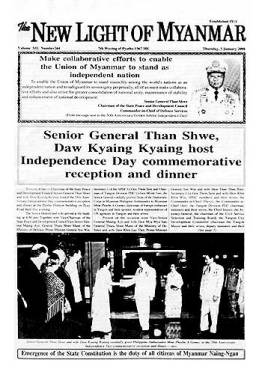Reading Between the Lines
By Stephen Brookes in Yangon
For Asia Times
I was sitting in a Yangon restaurant waiting for a friend the other day, and was deeply immersed in the New Light of Myanmar -- the official newspaper here -- when he arrived. "Sorry I'm late," he said, then noticed the paper. "Do you actually read that thing?" he asked, with an exaggerated grimace of distaste.
 "I have to, it's part of my job," I said, folding the paper quickly into my briefcase. But the truth is that, though the state-run paper is written like a Soviet tank manual and has all the flair and vitality of a grocery list, I read it every day -- and find it fascinating.
"I have to, it's part of my job," I said, folding the paper quickly into my briefcase. But the truth is that, though the state-run paper is written like a Soviet tank manual and has all the flair and vitality of a grocery list, I read it every day -- and find it fascinating.
For the New Light of Myanmar is the English-language voice of the military State Peace and Development Council. It's the main vehicle the SPDC uses to explain itself to the outside world, and it's much like the junta itself -- stolid, no-nonsense and deeply reluctant to divulge information. If you're looking for lively, in-depth news and analysis, the New Light is not the place to look. Most real information flows on the rumor mill in Myanmar, not in the papers. But for insight into how the SPDC sees itself, there's no better source.
Of course, it's sometimes a tough slog -- this is a government, remember, that even has a censorship board for calendars. They don't have to worry about boosting circulation, or getting more advertisers, or beating the competition. There is no competition. So there aren't any features, "lifestyle" stories, feisty op-ed pages or comics. They don't even have Doonesbury.
In fact, even its staffers admit that the paper is a tad formulaic. Each day starts with a stern recitation of the SPDC's sixteen political, economic and social objectives and then takes off from there. There are firm exhortations to the citizenry to drive safely, not to smoke, and to uphold the emergence of a constitution. If a new ambassador has been appointed from somewhere, there will be a solemn announcement. If a top official makes a speech, the speech will be reprinted down to the last syllable. If a government minister tours a new beanfield, there will be a new beanfield story.
Yet, the paper can be oddly charming in spite of itself. On slow news days, page two will sport an old-fashioned photo of a young woman posing in front of a pagoda with a clunky caption like, "Two samples of Myanmar beauty." (This is in the "Come, Visit Myanmar" section.) The government is always running competitions and festivals of one kind or another; last week the results of the Mayor's Cup Fruit and Flower Show were announced, including the winners of the "foreign orchids event", the "garden croton event" and, of course, the "fern event".
But hard news in Myanmar is tougher to find. The notions of "useful information" and "story line" are not well-developed, and most articles are simply a statement that a certain event occurred, with a long list of the people who attended. A typical front-page story will note that a top SPDC official visited a construction site, name every member of his entourage, then reveal that the official "issued necessary instructions to the authorities concerned". End of story.
 But even such lists can provide useful glimpses into life in Yangon. Take the January 4 article on the opening of a new furniture showroom. Pretty boring, right? And the story just noted that a company called Sinma Furnishings opened the shop with its business partner. Simple enough -- except that the partner is the Welfare Society of the Bureau of Special Investigation, and the attendees included the Minister for Home Affairs, the Director of Public Relations and Psychological Warfare, and the head of the Myanmar Police Force.
But even such lists can provide useful glimpses into life in Yangon. Take the January 4 article on the opening of a new furniture showroom. Pretty boring, right? And the story just noted that a company called Sinma Furnishings opened the shop with its business partner. Simple enough -- except that the partner is the Welfare Society of the Bureau of Special Investigation, and the attendees included the Minister for Home Affairs, the Director of Public Relations and Psychological Warfare, and the head of the Myanmar Police Force.
Fascinating business, furniture.
In fact, stories on international investment -- actual or potential -- tend to dominate the news. Like it or not, trade delegations and visiting heads of corporations usually get their pictures in the paper when they meet with government officials, with a short article noting who was present and a vague statement that "topics of mutual interest" were discussed. And in Visit Myanmar Year, the arrival of a shipload of tourists will usually merit a photo and short article noting the number of visitors, their nationality and, for some reason, the exact time the boat actually docked.
But often what's most interesting is the news that doesn't make it -- in other words, the political news. The events that propel Myanmar onto the front page of the international press are usually ignored in the New Light of Myanmar, and the release of opposition leader Aung San Suu Kyi from house arrest in 1995, the detention of hundreds of NLD members this past May, the student protests in December, the placement of tanks around the city -- all passed without a peep.
Of course, the paper does discuss many of these events -- but in the opinion section, not the news. There seem to be a tacit admission that everyone has heard the latest new on the grapevine, and the newpaper's job is to put the right spin on it. Suu Kyi's activities are never reported straight, for example, but rather discussed in long, pseudonymous and sometimes quite vicious essays on the dangers of "evil destructionists" and "dastardly neo-colonialism."
Analysts say that's partly because the SPDC is a large group, and needs time to discuss what response it will take to important events (which also explains the formulaic approach to reporting). But the exception to the "if-it's-on-CNN-it's-not-in-the-New Light of Myanmar" rule was a bombing late on the night of December 25, in which five people were killed.
To the interest of many in Yangon, the news was reported in the paper the very next morning -- an unusually rapid response that prompted the usual tea-leaf-reading in this rumor-prone city.
"Usually they keep any news on ice for a while, until everyone has agreed on how to play it," said one diplomat in Yangon. "It's fascinating that they reported this so quickly -- clearly there was no need to forge a consensus. But what exactly does that mean?"
References (8)
-
 Response: TV won\'t turn onAs yesterday was Friday, which is the equivalent of Saturday, I decided to sacrifice my precious sleeping privileges and take a tour, under the auspices of the Bauhaus Center of Tel Aviv. This style of architecture, technically known as the“ International Style” is incredibly prolific here, because the city was built ...
Response: TV won\'t turn onAs yesterday was Friday, which is the equivalent of Saturday, I decided to sacrifice my precious sleeping privileges and take a tour, under the auspices of the Bauhaus Center of Tel Aviv. This style of architecture, technically known as the“ International Style” is incredibly prolific here, because the city was built ... -
 Response: Nuclear WeaponsGood night
Response: Nuclear WeaponsGood night -
 Response: iPhone 11 Pro screen replacement
Response: iPhone 11 Pro screen replacement -
 Response: managementessay4u.com
Response: managementessay4u.com -
 Response: celeb height wiki
Response: celeb height wiki -
 Response: Veterans Day vs memorial DayFind the difference between
Response: Veterans Day vs memorial DayFind the difference between -
 Response: Agar Tum Saath Ho Lyrics - TamashaAgar Tum Saath Ho Lyrics from Tamasha is Hindi song in the voices of Arijit Singh, Alka Yagnik. Agar Tum Saath Ho song lyrics are written by Irshad Kamil, its tune is made by A R Rahman.
Response: Agar Tum Saath Ho Lyrics - TamashaAgar Tum Saath Ho Lyrics from Tamasha is Hindi song in the voices of Arijit Singh, Alka Yagnik. Agar Tum Saath Ho song lyrics are written by Irshad Kamil, its tune is made by A R Rahman. -
 Response: On The Way Lyrics - Hollow CovesOn The Way Lyrics by Hollow Coves is latest English song voiced by them, its music is given by Matt Corby. Brand new lyrics of On The Way song is written by Matt Carins, Ryan Henderson.
Response: On The Way Lyrics - Hollow CovesOn The Way Lyrics by Hollow Coves is latest English song voiced by them, its music is given by Matt Corby. Brand new lyrics of On The Way song is written by Matt Carins, Ryan Henderson.


Reader Comments